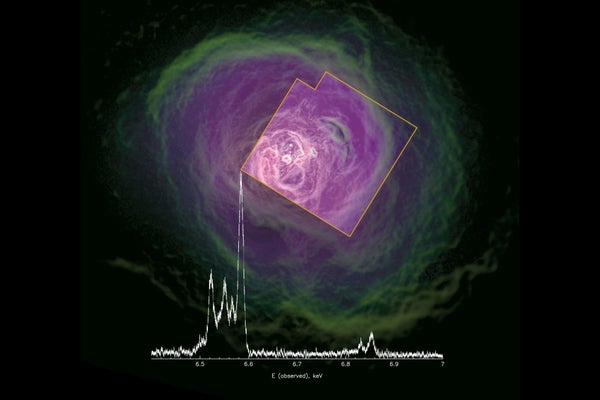Astronomers have waited years to get their hands on this kind of x-ray data from distant galaxy clusters—but it was short-lived. Japan’s Hitomi spacecraft launched to Earth orbit on February 17, and its instruments worked beautifully, giving researchers a taste of measurements from the most sensitive x-ray detector ever built. Yet just over a month later scientists completely lost contact with the craft, which was spinning out of control after a series of errors caused its thrusters to fire in the wrong direction.
That brief taste of initial data, however, was enough to provide a surprising picture of how black holes restrict the growth of galaxies, researchers report in a paper published this week in Nature. “The data were exquisite,” says Hitomi team member, astrophysicist Brian McNamara of the University of Waterloo in Ontario. “We’re really pleased with what we got but we’re pretty sad about what we didn’t get and what might have been.”
Hitomi was the third attempt to fly a “microcalorimeter” in space—an instrument that is cooled almost to absolute zero and can read the precise energy of each incoming x-ray photon it receives. This provides high-resolution measurements of the various wavelengths of light coming from the wide field of view it observes. Hitomi’s microcalorimeter actually fared better than the first two—the Japanese space agency’s ASTRO-E satellite carried one, but that spacecraft blew up during launch in 2000. In 2005 Japan’s Suzaku satellite lifted off, but its microcalorimeter was ruined by a leak in its cooling system. Hitomi’s instrument, which was built primarily at NASA Goddard Space Flight Center in Maryland, at least returned data, albeit just a few days’ worth. “This is the third time—it’s so frustrating,” says University of California, Irvine, astrophysicist David Buote, who was not involved in the mission but has been waiting for data from an x-ray microcalorimeter for a long time. “But despite all of the problems that occurred, I think they were able to do quite a good job with what they had. It’s provided a measurement which up to now really hasn’t been possible before.”
On supporting science journalism
If you're enjoying this article, consider supporting our award-winning journalism by subscribing. By purchasing a subscription you are helping to ensure the future of impactful stories about the discoveries and ideas shaping our world today.
During the spacecraft’s commissioning phase it was pointed toward one of its prime targets: the giant galaxy cluster Perseus, about 240 million light-years away. Observed with visible light the hundreds of galaxies in the cluster stand out as clearly separate from one another, but through Hitomi’s x-ray eyes the galaxies blur together to reveal the vast clouds of gas that permeate and enshroud the entire cluster. Astronomers have long wondered how this gas was influenced by the supermassive black holes thought to reside at the centers of all the galaxies in Perseus. According to one theory, as mass fell into these black holes—in the form of bubbles of plasma—the energy that spewed out would stir up turbulence in the gas. Instead Hitomi found that the gas was relatively placid. It was, however, extremely hot. Rather than stirring up the gas, the energy coming from the black holes heated it up. “It is highly surprising that there is so little turbulent pressure support of the gas in such a highly active cluster system such as the Perseus cluster,” says astrophysicist Kevork Abazajian of the U.C. Irvine, who was not involved in the mission. He called the results “groundbreaking and very exciting.”
This kind of heating would likely put a serious damper on any star formation that might have taken place in the gas. To form stars, gas needs to be relatively cool, between 10 and 30 kelvins. The gas that Hitomi observed was between 10 million and 100 million kelvins. Essentially, the atoms in such supercharged gas move around too quickly for gravity to pull them in and birth stars. The new finding “means the supermassive black holes are very effectively controlling the rate at which the galaxy is growing,” McNamara says. “This is a fundamental insight because this is a mechanism that probably controls the growth of a large fraction of the galaxies in the universe. In that sense, it’s very exciting.”
The fact that turbulence is so low in the center of this galaxy cluster is also great news for scientists like Buote, who are interested in studying dark matter in clusters. Most scientists had assumed that high turbulence would throw off the accuracy of attempts to use x-ray observations of the gas in clusters’ centers to infer the spread of mass there. “This measurement has said you don’t have to worry about those random turbulent contributions. They’re small,” Buote says. “That’s important because the inner-mass haloes can tell you a lot about the properties of dark matter and the formation of these clusters.”
The discovery has whetted astronomers’ appetites for more data, which will likely be awhile in coming. “It’s a really promising and exciting result,” Buote says. “It says, ‘Gosh, we really need this type of instrument to get data as soon as possible.’” The next plans to fly a microcalorimeter in space involve the European Space Agency’s Athena mission, which is not due to launch until 2028. Some astronomers hope Hitomi’s brief success might motivate Japan and its partners to build a replacement—but even a copycat mission would be expensive, especially considering the additional work needed to prevent the glitches that doomed the first mission. “There’s hope in the community that we might get some sort of a reflight that would involve primarily a microcalorimeter,” McNamara says. “We’re hopeful, but only cautiously. It certainly has demonstrated the power of this instrument and the need to get one into space in the future.”
